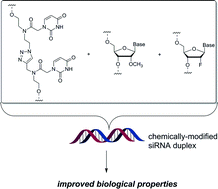Synthesis and in vitro assessment of chemically modified siRNAs targeting BCL2 that contain 2′-ribose and triazole-linked backbone modifications†
Abstract
Short-interfering RNAs (siRNAs) are naturally occurring biomolecules used for post-transcriptional gene regulation, and therefore hold promise as a future therapeutic by silencing gene expression of overexpressed deleterious genes. However, there are many inherent problems with the native RNA structure. This project investigates the ability of a library of chemically modified siRNAs to target the therapeutically relevant oncogene, BCL2, by combining 2′-ribose sugar modifications with a novel triazole-linked backbone modification, previously described by our group. Solid support phosphoramidite chemistry was used to incorporate chemical modifications at various positions within anti-BCL2 siRNAs. In vitro effects were evaluated through qPCR, cell viability, nuclease stability, and an ELISA assay. Our results indicate that these unique modifications are well tolerated within RNAi and show enhanced activity and stability over natural siRNAs, while also improving upon inherent issues of toxicity and immunological activity.


 Please wait while we load your content...
Please wait while we load your content...